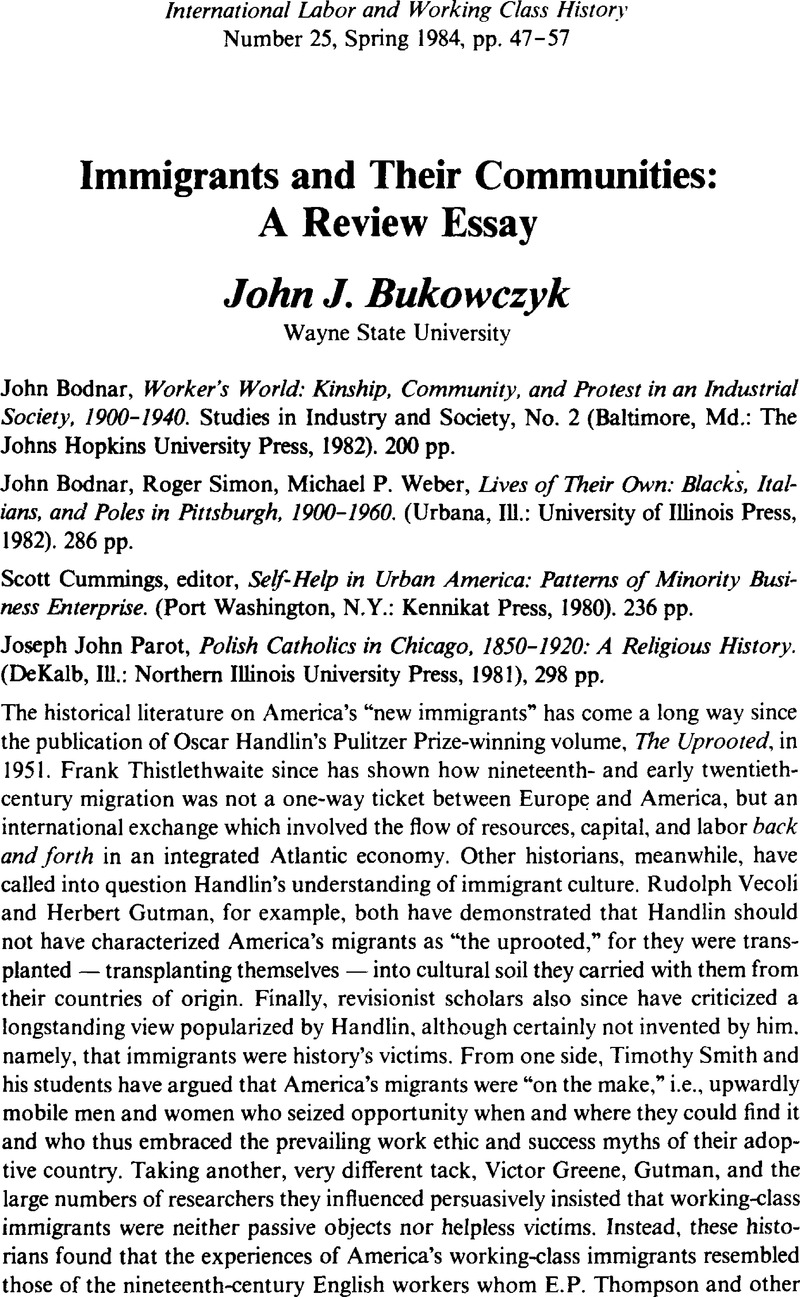No CrossRef data available.
Published online by Cambridge University Press: 16 December 2008

1. See Handlin, Oscar, The Uprooted (Boston: Little. Brown. 1951)Google Scholar: Thistlethwaite, Frank. “Migration from Europe Overseas in the Nineteenth and Twentieth Centuries.” Rapports, Comite international Des Sciences Historiques, Xle Congrès International Des Sciences Historiques (Stockholm, 1960), V, 32–60Google Scholar; Vecoli, Rudolph J..“‘Contadini’ in Chicago: A Critique of The Uprooted,” Journal of American History, 51 (1964), 404–417CrossRefGoogle Scholar; Gutman, Herbert, “Work. Culture, and Society in Industrializing America, 1815–1919,” American Historical Review, 128 (1973), 531–588CrossRefGoogle Scholar; Smith, T.L.. “Immigrant Social Aspirations and American Education, 1880–1930,” American Quarterly 21 (Fall, 1969)CrossRefGoogle Scholar; Greene, Victor R., The Slavic Community on Strike: immigrant Labor in Pennsylvania Anthracite (Notre Dame, Ind., 1968)Google Scholar; Thompson, E.P., The Making of the English Working Class (New York, 1963).Google Scholar
2. Throughout this time, a minority of scholars continued to emphasize the older historiographical tradition which had focused on immigrant docility. See, for example, Rosenblum, Gerald, Immigrant Workers: Their Impact on American Labor Radicalism (New York, 1973)Google Scholar; Kolko, Gabriel, Main Currents in Modem American History (New York, 1976), chapter threeGoogle Scholar.
3. See, for example, Ellis, John Tracy, American Catholicism, second edition, revised (Chicago, 1969)Google Scholar; or James, Hennesey S.J., American Catholics: A History of the Roman Catholic Community in the United States (New York, 1981)Google Scholar.
4. Other recent treatments of immigrants and religion that are worthy of note include Vecoli, Rudolph J., “Prelates and Peasants: Italian Immigrants and the Roman Catholic Church,” Journal of Social History, 2 (1969), 217–268CrossRefGoogle Scholar; Dolan, Jay, The Immigrant Church: New York's Irish and German Catholics, 1815–1865 (Baltimore, Md., 1975)Google Scholar; Immigrants and Religion in Urban America, ed. Miller, Randall M. and Marzik, Thomas D. (Philadelphia, 1977)Google Scholar; Kuzniewski, Anthony J., Faith and Fatherland: The Polish Church War in Wisconsin, 1896–1918 (Notre Dame, Ind., 1980)Google Scholar; and Orton, Lawrence D., Polish Detroit and the Kolasinski Affair (Detroit, Michigan, 1981)Google Scholar.
5. Cf. Greene, Victor, For God and Country: The Rise of Polish and Lithuanian Ethnic Consciousness in America, 1860–1910 (Madison, 1975).Google Scholar
6. Cf. Bukowczyk, John J., “The Immigrant ‘Community’ Re-examined: Political and Economic Tensions in a Brooklyn Polish Settlement, 1888–1894,” Polish American Studies 37 (Autumn, 1980), 5–16Google Scholar; Bukowczyk, , “Factionalism and the Composition of the Polish Immigrant Clergy,” Pastor of the Poles, ed. Blejwas, S. and Biskupski, M., Polish Studies Monographs, No. 1 (New Britain, Conn., 1982), 37–47Google Scholar.
7. Rosentraub, Mark S. and Taebel, Delbert, “Jewish Enterprise in Transition: From Collective Self–Help to Orthodox Capitalism,” in Cummings, 214Google Scholar.
8. On immigrant social mobility, see Thernstrom, Stephan, The Other Bostonians: Poverty and Progress in the American Metropolis, 1880–1970 (Cambridge, Mass., 1973)CrossRefGoogle Scholar; Barton, Josef J., Peasants and Strangers: Italians, Rumanians, and Slovaks in an American City, 1890–1950 (Cambridge, Mass., 1975)CrossRefGoogle Scholar; Kessner, Thomas, The Golden Door: Italian and Jewish Immigrant Mobility in New York City, 1880–1915 (New York, 1977)Google Scholar; and Lieberson, Stanley, A Piece of the Pie: Blacks and White Immigrants Since 1880 (Berkeley, Cal., 1980).Google Scholar
9. Cf. Bodnar, John, “Immigration and Modernization: The Case of Slavic Peasants in Industrial America,” Journal of Social History, 10 (Fall, 1976), 44–67CrossRefGoogle Scholar; Bodnar, , Immigration and Industrialization: Ethnicity in an American Mill Town, 1870–1940 (Pittsburgh, Pa., 1977)CrossRefGoogle Scholar; Weber, Bodnar, and Simon, , “Migration, Kinship, and Urban Adjustment: Blacks and Poles in Pittsburgh, 1900–1930,” Journal of American History, 66 (12, 1979), 548–565Google Scholar; Bodnar, , “Immigration, Kinship, and the Rise of Working Class Realism in Industrial America,” Journal of Social History, 14 (Fall, 1980), 45–65.CrossRefGoogle Scholar
10. Cf. Dollard, John, Criteria for Life History (New York, 1949)Google Scholar.
11. See Bodnar, , Immigration and IndustrializationGoogle Scholar.
12. Yezierska, Anzia, Bread Givers: A Struggle Between a Father of the Old World and a Daughter of the New (New York, 1977)Google Scholar; Cooper, Patricia Ann. “From Hand Craft to Mass Production: Men, Women, and Work Culture in American Cigar Factories, 1900–1919” (forthcoming, University of Illinois Press).Google Scholar
13. See Bukowczyk, John J., “Polish Rural Culture and Immigrant Working Class Formation.” Polish American Studies, forthcomingGoogle Scholar.
14. Karni, Michael, “Finnish-American Cooperativism: The Radical Years. 1917–30.” in Cummings, 145–159.Google Scholar